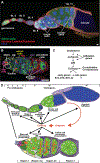Nuclear receptors linking physiology and germline stem cells in Drosophila
- PMID: 33752824
- PMCID: PMC8063499
- DOI: 10.1016/bs.vh.2020.12.008
Nuclear receptors linking physiology and germline stem cells in Drosophila
Abstract
Maternal nutrition and physiology are intimately associated with reproductive success in diverse organisms. Despite decades of study, the molecular mechanisms linking maternal diet to the production and quality of oocytes remain poorly defined. Nuclear receptors (NRs) link nutritional signals to cellular responses and are essential for oocyte development. The fruit fly, Drosophila melanogaster, is an excellent genetically tractable model to study the relationship between NR signaling and oocyte production. In this review, we explore how NRs in Drosophila regulate the earliest stages of oocyte development. Long-recognized as an essential mediator of developmental transitions, we focus on the intrinsic roles of the Ecdysone Receptor and its ligand, ecdysone, in oogenesis. We also review recent studies suggesting broader roles for NRs as regulators of maternal physiology and their impact specifically on oocyte production. We propose that NRs form the molecular basis of a broad physiological surveillance network linking maternal diet with oocyte production. Given the functional conservation between Drosophila and humans, continued experimental investigation into the molecular mechanisms by which NRs promote oogenesis will likely aid our understanding of human fertility.
Keywords: Drosophila; EcR; Ecdysone; Eip74EF; Eip75B; Eip78C; Germ cell; Nuclear hormone receptor; Oocyte; Oogenesis; Steroid hormone; Usp.
Copyright © 2021 Elsevier Inc. All rights reserved.
Figures





References
Publication types
MeSH terms
Substances
Grants and funding
LinkOut - more resources
Full Text Sources
Other Literature Sources
Molecular Biology Databases

